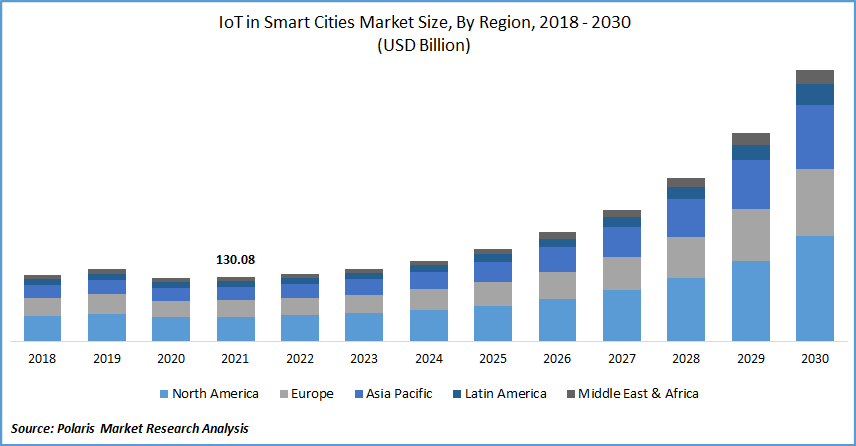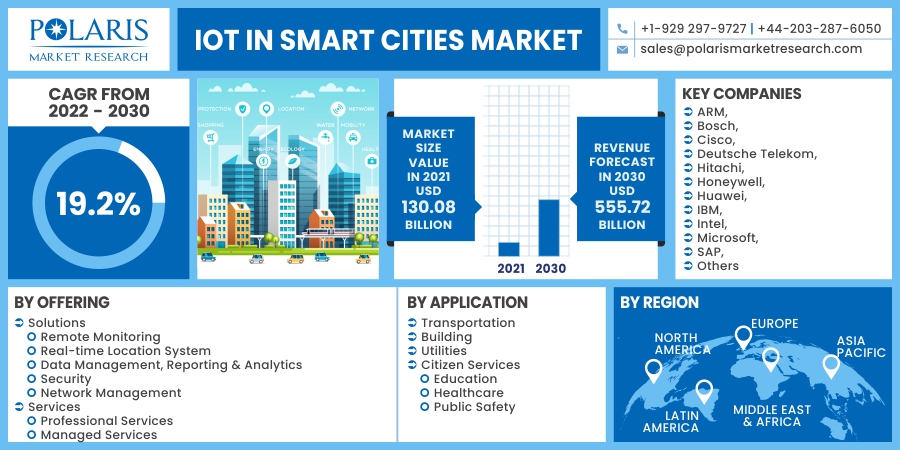
IoT in Smart Cities Market Share, Size, Trends, Industry Analysis Report
By Offering (Solutions {Remote Monitoring, Real-time Location System, Data Management, Reporting & Analytics, Security, Network Management}, Services {Professional Services, Managed Services}), By Application; By Region; Segment Forecast, 2022 - 2030
- Published Date:May-2022
- Pages: 114
- Format: PDF
- Report ID: PM2378
- Base Year: 2021
- Historical Data: 2018 - 2020
Report Outlook
The global IoT in smart cities market was valued at USD 130.08 billion in 2021 and is expected to grow at a CAGR of 19.2% during the forecast period. The emergence of innovative solutions and services in IoT in the smart cities market, coupled with the development of city monitoring and infrastructure management, is the major factor that may augment the industry growth.
 Know more about this report: request for sample pages
Know more about this report: request for sample pages
In addition, rising investment by the various regulatory bodies such as city governments, central/federal governments, and governing organizations for infrastructure development plays a vital role in the development of the IoT in the smart cities market. Furthermore, growing urbanization, increasing proliferation of the connected and IoT in smart cities initiatives, and the rise in the number of development projects of smart cities globally are further creating lucrative opportunities for the industry demand over the forthcoming years.
The outbreak of COVID-19 has shown a substantial impact on every sector of the economy globally. The COVID-19 pandemic negatively affected the various intelligent projects of cities owing to the imposition of lockdowns in various regions, highly affected the unavailability of the workforce, logistics, production, and distribution chain, and increases the cost of hardware. The intelligent cities offer a variety of data that helps in contact tracking that is significantly helpful during emergency scenarios, maintaining cleanliness, detecting people without masks, or not retaining hygiene in communal spaces.
The IoT in Smart Cities Market report details key market dynamics to help industry players align their business strategies with current and future trends. It examines technological advances and breakthroughs in the industry and their impact on the market presence. Furthermore, a detailed regional analysis of the industry at the local, national, and global levels has been provided.
For instance, IoT technology assists people in finding unoccupied beds in the COVID-19 hospitals. Accordingly, during this pandemic regulatory bodies of various nations are highly emphasized in monitoring the living standards, health, and safety of their citizens. Hence, the gradual opening of lockdown and the emergence of innovative technologies are anticipated to present various lucrative opportunities in the approaching period.
Industry Dynamics
Growth Drivers
The increasing number of initiatives of smart cities across the globe is one of the major driving factors for IoT in smart city market growth. The integration of IoT in smart city projects is propelling the need for smart security solutions, like the Perimeter Intrusion Detection System (PIDS), for protecting the boundaries of the region.
Also, there is a rising inclination towards efficient energy management solutions for ensuring suitable metering and decreasing the wastage of resources. The development of the transportation infrastructure in the smart cities projects is further attracting IoT technology providers for better control and monitoring facilities, cutting down carbon emissions, and also offers competent optimization and planning of the roadways.
Accordingly, various nations are heavily investing in integrating novel technologies to upgrade their legacy infrastructure. For instance, the Indian Government planned to invest USD 7.51 billion in 2016 to transform 100 present cities into intelligent cities. Moreover, according to the article published by the American Society of Mechanical Engineers in February 2020, the Singapore government initiated the deployment of solar panels installed on rooftops of 6,000 buildings and intellectual, energy-efficient lighting for every public road by 2022.
Also, Norway introduced its plans to build a sustainable smart city near Oslo’s airport on 260 acres of land to advance technology-driven communities. Therefore, these factors are projected to stimulate the market demand in the approaching years.

Know more about this report: request for sample pages
Report Segmentation
The market is primarily segmented on the basis of offering, application, and region.
|
By Offering |
By Application |
By Region |
|
|
|
Know more about this report: request for sample pages
Insight by Component
The solution segment is recorded to hold the largest revenue share. The integration of the IoT solutions in the emerging technologies facilitates infrastructure safer, equitable society, reduces the crime rate, and also offers technologically advanced surroundings. The reporting and analytics solution is highly adopted by the population as it enables organizations to use all extents of data and control the geospatial dimensions power.
Also, it provides comprehended interactions and consequences properly through dashboards and reports and allows authorities to make data-based decisions. Moreover, various solutions aid in processing IoT technology for enabling applications to incorporate the streaming data and rapidly generate extracted data from numerous sources in real-time. Thereby, these solutions are also presented as Customer Relationship Management (CRM), privacy protection services, fraud detection, and reliable analysis of data-generated IoT devices.
The service segment is projected to account for the highest growth rate in the forecasting years. The service providers in the market present a variety of services, such as managed services and professional services. These services enable smooth and effective development, implementation, and maintenance of current activities in organizations.
These service providers support and help customers, partners, employees, marketing teams, and support teams with personal development and training activities. Additionally, managed services comprise end-to-end services that are allied with IoT in the smart cities market. Thus, it may decrease the incidences of hassle in the managing performance and deployment of the platforms.
Furthermore, the growing adoption of digital transformation services in many industries, such as buildings, utilities, transportation, and many others, improves operational performance and gains a smarter enterprise. Thereby, these factors are leading the segment growth in the near future.
Geographic Overview
North America accounted for the largest revenue share in the global market. The region is more likely to use IoT-based solutions and services owing to the availability of sustainable and well-established economies. Additionally, increasing investment in R&D activities, thus, these factors leads to the advancement of novel technologies. Moreover, network operators in the region are more likely to invest in strengthening and enhancing their telecom networks and working on the development of the 5G infrastructure, such as network slicing and cloud edge computing, rising adoption of IoT in smart cities market for economic and strategic urban management.
Furthermore, the rapid digitalization in numerous segments and increasing proliferation of smart connected IoT devices further propels the adoption of the IoT in the smart cities market. Therefore, these factors are propelling the market demand across the region.
Moreover, the Asia Pacific market is anticipated to exhibit the highest CAGR over the forecasting years. The growing responsiveness about the novel technologies and proliferation of IoT devices in the region also boosted the business productivity and attracted various leading companies to offer smart services, which offer various growth prospects market. Also, the countries such as South Korea, India, Japan, China, Australia, etc., are developed or developing regions in APAC that highly produce information technology products, automobiles, and electronic products.
Additionally, various companies are undertaking momentous steps to implement IoT solutions and services in development projects of smart cities to fulfill the rising needs for data quality and control in both small & medium enterprises and large enterprises. Therefore, the rising popularity of advanced technologies such as big data analytics and AI has propelled the market demand across the APAC region.
Competitive Insight
Some of the major players operating in the global market include ARM, Bosch, Cisco, Deutsche Telekom, Hitachi, Honeywell, Huawei, IBM, Intel, Microsoft, SAP, Schneider Electric, Siemens, Tech Mahindra, and Verizon.
IoT in Smart Cities Market Report Scope
|
Report Attributes |
Details |
|
Market size value in 2021 |
USD 130.08 Billion |
|
Revenue forecast in 2030 |
USD 555.72 Billion |
|
CAGR |
19.2% from 2022 - 2030 |
|
Base year |
2021 |
|
Historical data |
2018 - 2020 |
|
Forecast period |
2022 - 2030 |
|
Quantitative units |
Revenue in USD Million/Billion and CAGR from 2022 to 2030 |
|
Segments covered |
By Offering, By Application, By Region |
|
Regional scope |
North America, Europe, Asia Pacific, Latin America, Middle East & Africa |
|
Key companies |
ARM, Bosch, Cisco, Deutsche Telekom, Hitachi, Honeywell, Huawei, IBM, Intel, Microsoft, SAP, Schneider Electric, Siemens, Tech Mahindra, and Verizon |
The IoT in Smart Cities Market report details key market dynamics to help industry players align their business strategies with current and future trends. It examines technological advances and breakthroughs in the industry and their impact on the market presence. Furthermore, a detailed regional analysis of the industry at the local, national, and global levels has been provided.
Browse Our Top Selling Reports
Financial Wellness Software Market Size, Share 2024 Research Report
Immersive Entertainment Market Size, Share 2024 Research Report
M2M Satellite Communication Market Size, Share 2024 Research Report
Cancer Contrast Media Market Size, Share 2024 Research Report
Gummy Market Size, Share 2024 Research Report
